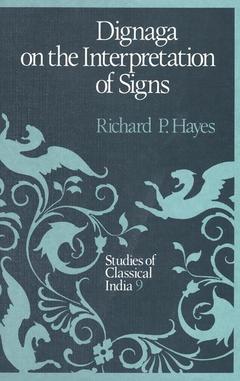Dignaga on the Interpretation of Signs, Softcover reprint of the original 1st ed. 1988 Studies of Classical India Series, Vol. 9
Langue : Anglais

Buddhist philosophy in India in the early sixth century C. E. took an important tum away from the traditional methods of explaining and systematizing the teachings in Siitra literature that were attributed to the Buddha. The new direction in which several Indian Buddhist philosophers began to move was that of following reasoning to its natural conclusions, regardless whether the conclusions conflicted with traditional teachings. The central figure in this new movement was DiIinaga, a native of South India who found his way to the centre of Buddhist education at Nalanda, studied the treatises that were learned by the Buddhist intellectuals of his day, and eventually wrote works of his own that formed the core of a distinctly new school of Buddhist thought. Inasmuch as virtually every Indian philosopher after the sixth century had either to reject Dirinaga's methods or build upon the foundations provided by his investigations into logic, epistemology and language, his influence on the evolution of Indian philosophy was considerable, and indeed some familiarity with Dirinaga's arguments and conclusions is indispensable for anyone who wishes to understand the historical development of Indian thought. Moreover, since the approach to Buddhism that grew out of Dirinaga's meditations on language and the limits of knowledge dominated the minds of many of the scholars who took Buddhism to Tibet, some familiarity with Dirinaga is also essential to those who wish to understand the intellectual infrastructure of Tibetan Buddhist philosophy and practice.
1: Preliminaries.- 1.1 The central issues.- 1.2 The contributions of previous scholars.- 1.2.1 Satis Chandra Vidy?bh??a?a.- 1.2.2 Th. Stcherbatsky.- 1.2.3 Satkari Mookerjee.- 1.2.4 Erich Frauwallner.- 1.2.5 Kitagawa Hidenori, Hattori Masaaki and Katsura Shoryu.- 1.2.6 Radhika Herzberger.- 1.3 The argument of this book.- Notes.- 2: Rational Skepticism in Pre-Di?n?gan Buddhism.- 2.1 The foundation of skepticism in the Nik?yas.- 2.1.1 The Sutta Nip?ta.- 2.1.2 D?gha Nik?ya: The Brahmaj?la sutta.- 2.1.3 A?guttara Nik?ya: The Kesaputtas.- 2.1.4 Summary of how opinions are regarded in the Nik?yas.- 2.2 The influence of N?g?rjuna.- 2.2.1 M?lamadhyamakak?ik?.- 2.2.2 Vigrahavy?vartan?.- Notes.- 3: Nominalism in Pre-Di?n?gan Buddhism.- 3.1 The ?gama literature and Milindapañha.- 3.1.1 Natural class in the Nik?yas.- 3.1.2 Personal identity in the P?li Canon.- 3.1.3 Personal identity in the Milindapañha.- 3.2 Nominalism in N?g?rjuna.- 3.3 Nominalism in Vasubandhu.- 3.3.1 Vasubandhu’s theory of two truths.- 3.3.2 Vasubandhu’s phenomenalism.- Notes.- 4: Di?n?ga’s Theory of Knowledge.- 4.1 Hetucakranir?aya.- 4.2 The Pram??asamuccaya.- 4.2.1 Sensation in the Pram??asamuccaya.- 4.2.1.1 Awareness’s awareness of itself.- 4.2.2 Inference in the Pram??asamuccaya.- 4.2.2.1 The subject matter of inference.- 4.2.2.2 Three characteristics of legitimate evidence.- 4.2.2.3 On errancy and pervasion.- 4.3 The skepticism implicit in Di?n?ga’s epistemology.- Notes.- 5: Di?n?ga’s nominalism.- 5.1 The ?lambanapar?k??.- 5.2 The context of the discussion of nominalism in the Pram??asamuccaya.- 5.2.1 Scripture as a form of inferential sign.- 5.2.2 Fallibility in inference and scripture.- 5.2.3 The question of uni versais.- 5.2.4 Any?poha as a substitute for universals.- 5.2.5 The nature of information conveyed by language.- 5.2.6 The meaning of individual words.- 5.2.7 Particulars as instantiations of universals.- 5.2.8 Absurdities in the view that universals exist outside thought.- 5.2.9 The contrariety of expressions.- 5.2.10 The meaning of a sentence.- 5.2.11 The sentence as the primary linguistic symbol.- Notes.- Translations Introduction to translation.- The history of the Pram??asamuccaya in Tibet.- 6: Pram??asamuccaya II “On reasoning”.- 6.1 Inference differentiated from sensation.- 6.2 The three characteristics of legitimate evidence.- 6.3 Property-bearer as the subject of inference.- 6.4 On restricted and errant properties.- 6.5 Non-symmetry of restriction and pervasion.- Notes.- 7: Pram??asamuccaya V: On the nature of signs in language.- 7.1 On the question of what verbal symbols make known.- 7.2 On the relationships between symbols that express preclusion.- 7.3 On the unreality of universals outside thought.- 7.4 On the question of what linguistic symbols preclude.- Notes.- 8: Conclusions.- Appendix A: Glossary of Sanskrit Terms.- Appendix B: Tibetan-Sanskrit Lexicon.- Selected Bibliography.- Subject and Author Index.
Date de parution : 01-2012
Ouvrage de 365 p.
15.5x23.5 cm
Thème de Dignaga on the Interpretation of Signs :
Mots-clés :
Buddhism; English literature; epistemology; foundation; history of literature; individual; interpret; issue; language; literature; nature; reason; skepticism; subject; translation
© 2024 LAVOISIER S.A.S.



